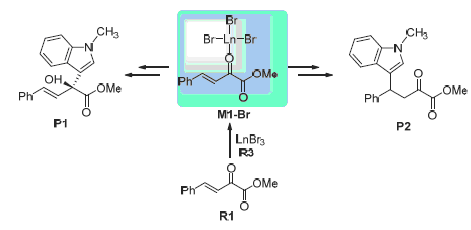| [1] Marckwald, W.; Desch, B. Chem. Res. 1904, 37, 1368.
[2] Qi, L.; Jiang, B. Acta Acad. Med. Zunyi 2004, 2, 188 (in Chinese). (企兰, 江波, 遵义医学院学报, 2004, 2, 188.)
[3] Zhang, W. H.; Yang, C. L.; Wang, M. H. Chin. J. Org. Chem. 2003, 23, 741 (in Chinese). (章维华, 杨春龙, 王鸣华, 有机化学, 2003, 23, 741.)
[4] Liu, S. M. J. Southwest Univ. Sci. Technol. 2005, 20, 68 (in Chinese). (刘思曼, 西南科技大学学报, 2005, 20, 68.)
[5] Wang, Y. F.; Wang, K.; Zhang, W.; Zhang, B. B.; Zhang, C. X.; Xu, D. Q. Eur. J. Org. Chem. 2012, 19, 3691.
[6] Wang, Y. F.; Chen, R. X.; Wang, K.; Zhang, B. B.; Li, Z. B.; Xu, D. Q. Green Chem. 2012, 14, 893.
[7] Terrasson, V.; de Figueiredo, R. M.; Campagne, J. M. Eur. J. Org. Chem. 2010, 14, 2635.
[8] Jensen, K. B.; Thorhauge, J.; Hazell, R. G.; Jorgensen, K. A. Angew. Chem., Int. Ed. 2001, 40, 160.
[9] Zhou, J.; Tang, Y. J. Am. Chem. Sco. 2002, 124, 9030..
[10] Bandini, M.; Fagioli, M.; Melchiorre, P.; Melloni, A.; Umani-Ronchi, A. Tetrahedron Lett. 2003, 44, 5843.
[11] Blay, G.; Fernández, I.; Pedro, J. R.; Vila, C. Org. Lett. 2007, 9, 2601.
[12] Desimoni, G.; Faita, G.; Toscanini, M.; Boiocchi, M. Chem.-Eur. J. 2008, 14, 3630.
[13] Zhang, L.; Zheng, Y.; Pan, X. X. Chin. J. Org. Chem. 2014, 34, 1595 (in Chinese). (张林, 郑妍, 潘晓晓, 有机化学, 2014, 34, 1595.)
[14] Reddi, Y.; Sunoj, R. B. ACS Catal. 2015, 5, 1596.
[15] McKeown, B. A.; Gonzalez, H. E.; Friedfeld, M. R.; Gunnoe, T. B.; Cundari, T. R.; Sabat, M. J. Am. Chem. Soc. 2011, 133, 19131.
[16] Yuan, Q. L.; Zhou, X. T.; Ji, H. B. Catal. Commun. 2010, 37, 785.
[17] Becke, A. D. J. Phys. Chem. C 1993, 98, 5648.
[18] Lee, C.; Yang, W.; Parr, R. G. Phys. Rev. B 1988, 37, 785.
[19] Miehlich, B.; Savin, A.; Stoll, H.; Preuss, H. Chem. Phys. Lett. 1989, 157, 200.
[20] Baron, V.; Cossi, M. J. Phys. Chem. A 1998, 102, 1995.
[21] Gonzalez, C.; Schlegel, H. B. J. Phys. Chem. C 1989, 90, 2154.
[22] Gonzalez, C.; Schlegel, H. B. J. Phys. Chem. C 1990, 94, 5523.
[23] Reed, A. E.; Weinhold, F.; Curtiss, L. A. Chem. Rev. 1988, 88, 899.
[24] Bader, R. F. W. Chem. Rev. 1991, 91, 893.
[25] Frisch, M. J.; Trucks, G. W.; Schlegel, H. B.; Scuseria, G. E.; Robb, M. A.; Cheeseman, J. R.; Scalmani, G.; Barone, V.; Mennucci, B.; Petersson, G. A.; Nakatsuji, H.; Caricato, M.; Li, X.; Hratchian, H. P.; Izmaylov, A. F.; Bloino, J.; Zheng, G.; Sonnenberg, J. L.; Hada, M.; Ehara, M.; Toyota, K.; Fukuda, R.; Hasegawa, J.; Ishida, M.; Nakajima, T.; Honda, Y.; Kitao, O.; Nakai, H.; Vreven, T.; Montgomery, J. J. A; Peralta, J. E.; Ogliaro, F.; Bearpark, M.; Heyd, J. J.; Brothers, E.; Kudin, K. N.; Staroverov, V. N.; Kobayashi, R.; Normand. J.; Raghavachari, K.; Rendell, A.; Burant, J. C.; Iyengar, S. S.; Tomasi, J.; Cossi, M.; Rega, N.; Millam, J. M.; Klene, M.; Knox, J. E.; Cross, J. B.; Bakken, V.; Adamo, C.; Jaramillo, J.; Gomperts, R.; Stratmann, R. E.; Yazyev, O.; Austin, A. J.; Cammi, R.; Pomelli, C.; Ochterski, J. W.; Martin, R. L.; Morokuma, K.; Zakrzewski, V. G.; Voth, G. A.; Salvador, P.; Dannenberg, J. J.; Dapprich, S.; Daniels, A. D.; Farkas, Ö.; Foresman, J. B.; Ortiz, J. V.; Cioslowski, J.; Fox, D. J. Gaussian 09, Revision A.02, Gaussian, Inc., Wallingford CT, 2009.
[26] Lv, J.; Zhang, L.; Zhou, Y. Angew. Chem. 2011, 123, 6740.
[27] Serr, A.; Netz, R. R. Int. J. Quantum Chem. 2006, 106, 2960.
[28] Jaequemin, D.; Preat, J.; Wathelet, V.; Perpete, E. A. Chem. Phys. 2006, 328, 324.
[29] Lin, S. T.; Hsieh, C. M. J. Chem. Phys. 2006, 125, 124103.
[30] Lalevee, J.; Allonas, X.; Jacques, P. J. Mol. Struct: THEOCHEM 2006, 767, 143.
[31] Jiang, H.; Wu, T.; Li, H. R. Acta Phys-Chim. Sin. 2006, 22, 1047 (in Chinese). (姜辉, 吴韬, 李浩然, 物理化学学报, 2006, 22, 1047.) |
